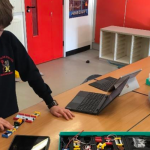With homeschooling, kids spend a lot of time in front of the screen. We know many of you as parents are concerned about your children. We came up with 5 activities that do not require screen and teach one of the most important skills of the 21st century: CODING!
1- Morning Routine Practice
How to play: Get yourself a piece of paper and write down your morning routine. The keystone of algorithmic thinking is to break things down into steps. The game starts with the question of what everyone does when they wake up and what the order of this routine is.Think about having breakfast and washing your face. How does one pass from one activity to other one? It is the concept of transitions! How does one change these steps? In the end, kids should have a structure of their morning routine and understand how they can modify it.
What you learn: Children will discover decomposition and transitions. They will learn how to break down a problem into smaller parts and define its pattern.
2- Teaching Robot Making Hot-dogs
How to play: Make a story about a robot just starting to work in a hot-dog restaurant. The kids are asked to teach the robot how to prepare these hot-dogs. Do not forget to mention that the robot is not a human, so it doesn’t know how to proceed with the food. They need to tell how they make a hot-dog. Then, you can ask them how they would tell these instructions to the robot. When they are ready, you can pretend to be the robot and make the hot-dogs according to their instructions. Let’s see if it tastes good.
What you learn: Decomposition is an important term to understand coding. Breaking down a task into small tasks is the basics of code development.
3- Algorithm Cups
How to play: First of all, you need to print the piece below to start the game. The kids are asked to record their design on this printable. Give kids cups to start their design. They can use these cups later on to ensure that their algorithm is accurate. You should describe what each symbol means in the algorithm. They may use all of these symbols for their design. They will form their stack accordingly.
What you learn: Children discover the concept of algorithms with this cup game.
4- Binary Messaging
How to play: Gather kids together and ask them to think of a secret message. Give them the ASCII code printable below. They need to transform their messages into ASCII codes as if they will store them in computers. Then, ask them to change their messages between one another. Now, they need to understand the message stored in their friend’s computer. Let’s see who is the fastest!
What you learn: Children will learn how information is stored in computers as binary values.
5- If…, Then…
How to play: In this game, one of the kids determines the actions of the others. For example, if he looks at them they need to stand still. If he raises his left arm, they need to dance. Children all agree on these signals and the game starts. This way, kids pretend like computers. They obey the rules as if they are the commands pressed. The command makes them do the related move. The list of moves is endless!
What you learn: Children will learn “If-Then” cause structure of coding. This is the logic that all computers were built on. Kids will discover how commands result in programming.



